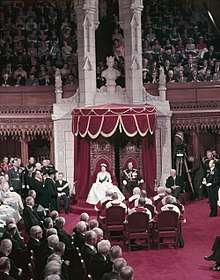Semi-formal wear
| Part of a series on |
| Western dress codes and corresponding attires |
|---|
 |
|
Supplementary
|
|
Legend: |
In Western clothing semi-formal is a grouping of dress codes indicating the sort of clothes worn to events with a level of protocol between informal (e.g., lounge suit) and formal. In the modern era, an evening dress or cocktail dress is customary for women.[1][2]
Variations
Whether one would choose to wear morning or evening semi-formal has traditionally been defined by whether the event will commence before or after 6:00 p.m.
In addition, equivalent versions of semi-formally applicable ceremonial dresses (including court dresses, diplomatic uniforms and academic dresses), full dress uniforms, religious clothing, and national costumes, and military mess dresses may be permitted.
Morning
In the daytime (before 6pm), the semi-formal code requires for men a black tail-less coat with formal (vertical black and grey stripes, or checked) trousers, with a black waistcoat. This combination is a less formal version of morning dress, which features a longer, cutaway morning coat. This semi-formal ensemble is sometimes referred to as a "stroller" in North America, or a Marlborough suit in the United Kingdom. Because black was then reserved for formalwear, it was unknown as a color for lounge suits, so the term was unambiguous. In the U.K. this mode of dress is now extremely unusual, though some Masonic Lodges which meet during the day rather than (as is more common) in the evening do continue to specify it as their dress code. It also still is worn within the legal profession, especially by barristers. Indeed, the striped trousers are in some circles referred to as "barrister trousers". In German, a stroller is called a Stresemann, after the German foreign secretary Gustav Stresemann. Stresemann, like other German politicians of his age, wore morning dress or a frock coat in the Reichstag or when making public appearances. However, Stresemann found the long coat impractical for daily work in the Chancellery. To avoid having to change completely, he began to wear the prototype of this jacket at his office, while switching to a morning coat when engaged on more formal business. The style quickly caught on as a more practical variation on morning dress. In Japan, it is known as a "director's suit", from the term inside director.
Evening
For evening wear, the corresponding code is black tie.[3] In formal evening dress, or white tie dress, this practice of substituting colors in ties is much less common since men's fashion tends to follow tradition more deeply as it becomes more formal.
The origins of evening semi-formal attire date back to the later 19th century when Edward, Prince of Wales (subsequently Edward VII), wanted a more comfortable dinner attire than the swallowtail coat.[4]
In the spring of 1886, the Prince invited James Potter, a rich New Yorker, and his wife Cora to Sandringham House, the Prince's hunting estate in Norfolk. When Potter asked for the Prince's dinner dress code, the Prince sent him to his tailor, Henry Poole & Co., in London, where he was given a suit made to the Prince's specifications with the dinner jacket.[5]
On returning to Tuxedo Park, New York, in 1886, Potter's dinner suit proved popular at the Tuxedo Park Club. Not long afterward, when a group of men from the club chose to wear such suits to a dinner at Delmonico's Restaurant in New York City, other diners were surprised. They were told that such clothing was popular at Tuxedo Park, so the particular cut then became known as the "tuxedo".[5]
From its creation into the 1920s, this dinner jacket was considered appropriate dress for dining in one's home or club, while the tailcoat remained in place as appropriate for public appearance.[4]
Etiquette and clothing experts continue to discourage wearing of black tie as too informal for weddings, or indeed any event before 6 p.m.,[6] such as by Emily Post (1872-1960) and Amy Vanderbilt (1908-1974). The latter arguing that "no man should ever be caught in a church in a tuxedo."
References
- ↑ Boswell, Sandra (2007). Protocol Matters. Canon Press. p. 181. ISBN 9781591280255.
After-five clothing is a subcategory of semiformal eveningwear. Often called the "cocktail dress," this type of dress if often made of shiny fabric and can be short, from being shorter than knee up to mid-calf, but seldom reaches to the ankle as does stricter semiformal evening wear.
- ↑ "Attire Guide: Dress Codes from Casual to White Tie - The Emily Post Institute". The Emily Post Institute. 2016. Retrieved 11 October 2016.
- ↑ Flusser, Alan (2002). Dressing the Man: Mastering the art of Permanent Fashion. New York: HarperCollins Publishers, Inc. p. 299. ISBN 0-06-019144-9.
- 1 2 Flusser, Alan (2002). Dressing the Man: Mastering the art of Permanent Fashion. New York: HarperCollins Publishers, Inc. p. 240. ISBN 0-06-019144-9.
- 1 2 Flusser, Alan (2002). Dressing the Man: Mastering the art of Permanent Fashion. New York: HarperCollins Publishers, Inc. pp. 240, 241, 303. ISBN 0-06-019144-9.
- ↑ Ford, Charlotte; DeMontravel, Jacqueline (2001). 21st century etiquette: a guide to manners for the modern age. Barnes & Noble Books. p. 210. ISBN 978-1-56731-629-2.
| Wikimedia Commons has media related to Black tie. |
